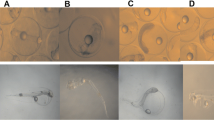Abstract
Two separate embryo through adult exposures were conducted with cadmium and with reduced pH levels to validate various test methodologies and to determine the feasibility of testing and ease of handling the freshwater snail (Aplexa hypnorum) in a test system designed for fish bioassays. Exposure of snails from embryos through adult reproductive maturity to cadmium chloride produced delayed hatch, reductions in percentage hatch and survival, and reduced growth when compared to a control. Based on these effects, the maximum acceptable toxicant concentration in Lake Superior water was between 4.41 and 7.63 μg cadmium/L in one test and between 2.50 and 4.79 μg cadmium/L in another test. Adult snails were exposed to determine a 96-hr LC50 of 93 μg cadmium/L. Exposure of embryonic, larval and adult snails to a pH range of 5.00–5.75 caused delayed hatching, reduced combined hatchability and survival, reduced 26-day growth, and a reduction in the number of egg masses per adult snail. No adverse effects were observed in snails exposed for 26 days to pH values ranging from 6.25 to 6.65. During a short-term static exposure, a pH of 4.3 caused a cloudy appearance in eggs within the egg mass and killed the embryos within two hr of the start of the exposure. A static pH exposure of 4.6 also turned embryos slightly cloudy, although some development did occur in these embryos by the sixth day.
Similar content being viewed by others
References
American Public Health Association, American Water Works Association, Water Pollution Control Federation (1980) Standard methods for the examination of water and waste-water. 15th ed. Washington, DC
Bartlett MS (1947) The use of transformation. Biometrics 3:39
Benoit DA, Puglisi FA (1973) A simplified flow-splitting chamber and siphon for proportional diluters. Water Res 7:1915
Biesinger KE, Christensen GM (1972) Effects of various metals on survival, growth, reproduction, and metabolism ofDaphnia magna. J Fish Res Board Can 29:1691
Chapman GA (1975) Toxicity of copper, cadmium, and zinc to Pacific Northwest salmonids. U.S. Environmental Protection Agency, Corvallis, OR
Clarke AH (1973) The freshwater molluscs of the Canadian Interior Basin. Malacologia 13
Eaton JG (1974) Chronic cadmium toxicity to the bluegill (Lepomis macrochirus Rafinesque). Trans Amer Fish Soc 4:729
European Inland Fisheries Advisory Commission (1969) Water quality criteria for European freshwater fish-extreme pH values and inland fisheries. Water Res 3:593
Garve JC (1980) The effects of depressed pH on the survival, growth, reproduction, and egg development of the pond snailHelisoma trivolvis. Masters Thesis, University of Minnesota, Duluth, MN
Gupta PK, Khangarot BS, Durve VS (1981) Studies on the acute toxicity of some heavy metals to an Indian freshwater pond snailViviparus bengalensis L. Arch Hydrobiol 91:259
Hamilton MA, Russo RC, Thurston RV (1977) Trimmed Spearman-Karber method for estimated median lethal concentrations in toxicity bioassays. Environ Sci Technol 7:714. Correction,12:417 (1978)
Menendez R (1976) Chronic effects of reduced pH on brook trout (Salvelinus fontinalis). J Fish Res Board Can 33:118
Mount DI (1973) Chronic effect of low pH on fathead minnow survival, growth, and reproduction. Water Res 7:987
Mount DI, Brungs WA (1967) A simplified dosing apparatus for fish toxicology studies. Water Res 1:21
Okland J, Okland KA (1980) Acidification threatens trout dietstudies of 1000 lakes in Norway. University of Oslo, P.O. Box 1027, Blindern, N-Oslo 3, Norway
Ravera O (1977) Effects of heavy metals (cadmium, copper, chromium, and lead) on a freshwater snail:Biomphalaria glabrata Say (Gastropoda, Prosobranchia). Proc Fifth Europ Malac Congr Malacologia 16:231
Rehwoldt R, Lasko L, Shaw C, Wirhowski E (1973) The acute toxicity of some heavy metal ions toward benthic organisms. Bull Environ Contam Toxicol 10:291
Spehar RL, Anderson RL, Fiandt JT (1978) Toxicity and bioaccumulation of cadmium and lead in aquatic invertebrates. Environ Pollut 15:195
Sprague JG (1969) Measurement of pollutant toxicity of fish. 1. Bioassay methods for acute toxicity. Water Res 3:793
Steel RGD, Torrie JH (1960) Principles and procedures of statistics with special reference to the biological sciences. New York: McGraw-Hill
U.S. Environmental Protection Agency (1979) Method for chemical analysis of water and wastes. EPA-600/4-79-020, Cincinnati, OH
— (1980) Ambient water quality criteria for cadmium. EPA-440/5-80-025. Office of Water Regulation and Standards, Criteria Standards Division, Washington, DC
Walton CL, Wright WR (1926) Hydrogen-ion concentration and the distribution ofLimnaea truncatula andL. peregra, with a note bearing on mosquitoes. Parasitology 18:24
Wier CF, Walter WM (1976) Toxicity of cadmium in the freshwater snail,Physa gyrina Say. J Environ Qual 5:359
Author information
Authors and Affiliations
Rights and permissions
About this article
Cite this article
Holcombe, G.W., Phipps, G.L. & Marier, J.W. Methods for conducting snail (Aplexa hypnorum) embryo through adult exposures: Effects of cadmium and reduced pH levels. Arch. Environ. Contam. Toxicol. 13, 627–634 (1984). https://doi.org/10.1007/BF01056342
Received:
Revised:
Issue Date:
DOI: https://doi.org/10.1007/BF01056342




